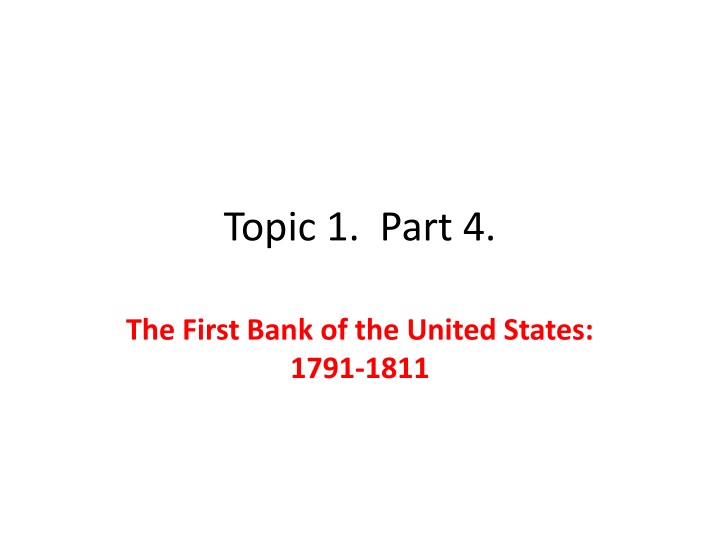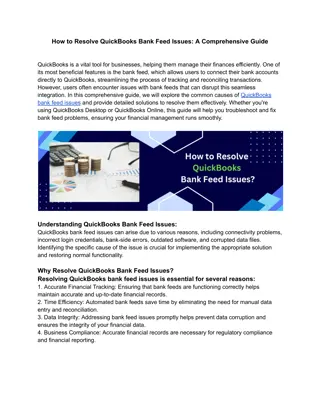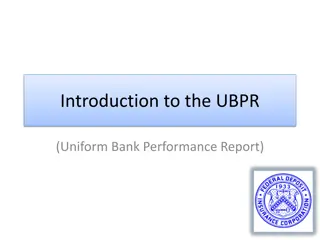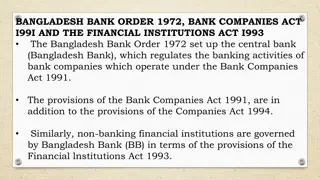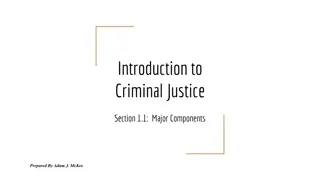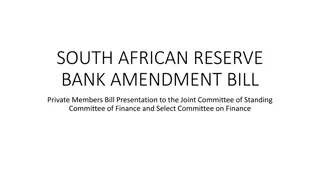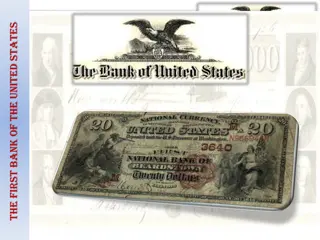The First Bank of the United States: Success and Controversy
The First Bank of the United States, established in 1791, was lauded for its successful management and liquidity. Despite its profitability, various factors led to its demise in 1811, including political suspicions, competition with state banks, foreign ownership, constitutional concerns, and public distrust of banking institutions.
Download Presentation

Please find below an Image/Link to download the presentation.
The content on the website is provided AS IS for your information and personal use only. It may not be sold, licensed, or shared on other websites without obtaining consent from the author.If you encounter any issues during the download, it is possible that the publisher has removed the file from their server.
You are allowed to download the files provided on this website for personal or commercial use, subject to the condition that they are used lawfully. All files are the property of their respective owners.
The content on the website is provided AS IS for your information and personal use only. It may not be sold, licensed, or shared on other websites without obtaining consent from the author.
E N D
Presentation Transcript
Topic 1. Part 4. The First Bank of the United States: 1791-1811
The First Bank of the United States is considered a success by economic historians. Treasury Secretary Albert Gallatian commented that the Bank was "wisely and skillfully managed."
Albert Gallatin, 29 January 1761 12 August 1849 Secretary of Treasury 1801-1814
The Bank carried a remarkable amount of liquidity. In 1809, for example, its specie/banknote ratio was about 40 percent (compared to a modern average reserve/deposit ratio of about 12 percent) making it probably the most liquid bank in the U.S. at the time.
The Bank was also profitable, earning most of its income through substantial loans to both government and private business. It helped to end several bank runs by transferring funds to banks in need of temporary liquidity. It also controlled the note issue by the State Banks by sending back their bank notes for redemption in specie when the rate of growth was deemed excessive.
If it was successful then why did The First Bank of the United States go out existence in 1811? Why was its Charter not Renewed?
The chief argument in favor of the Bank's renewal in 1811 was that its circulation of about $5 million in paper currency accounted for about 20 percent of the nation's money supply. It was the closest thing to a national currency that the U.S. had.
PROBLEMS: 1) The Bank Began as a Federalist Institution and the Jeffersonians were always suspicious of it. 2) The Bank's issuance of notes came at the expense of state banks. In addition, the currency issued by the Bank was not discounted, whereas the currency issued by the 712 state banks were discounted anywhere from 0 to 100 percent. 3) Foreign ownership. 4) Constitutional questions (the Supreme Court had yet to address the issue). 5) and a general suspicion of banking by the public at large.
The First Bank was huge compared to the private banks, and its business was a juicy morsel the private banks longed to gobble. Following the Bank's disappearance, state banks, unhindered by either state regulations or the discipline imposed by the Bank of the U.S., greatly increased the number of bank notes in circulation.
